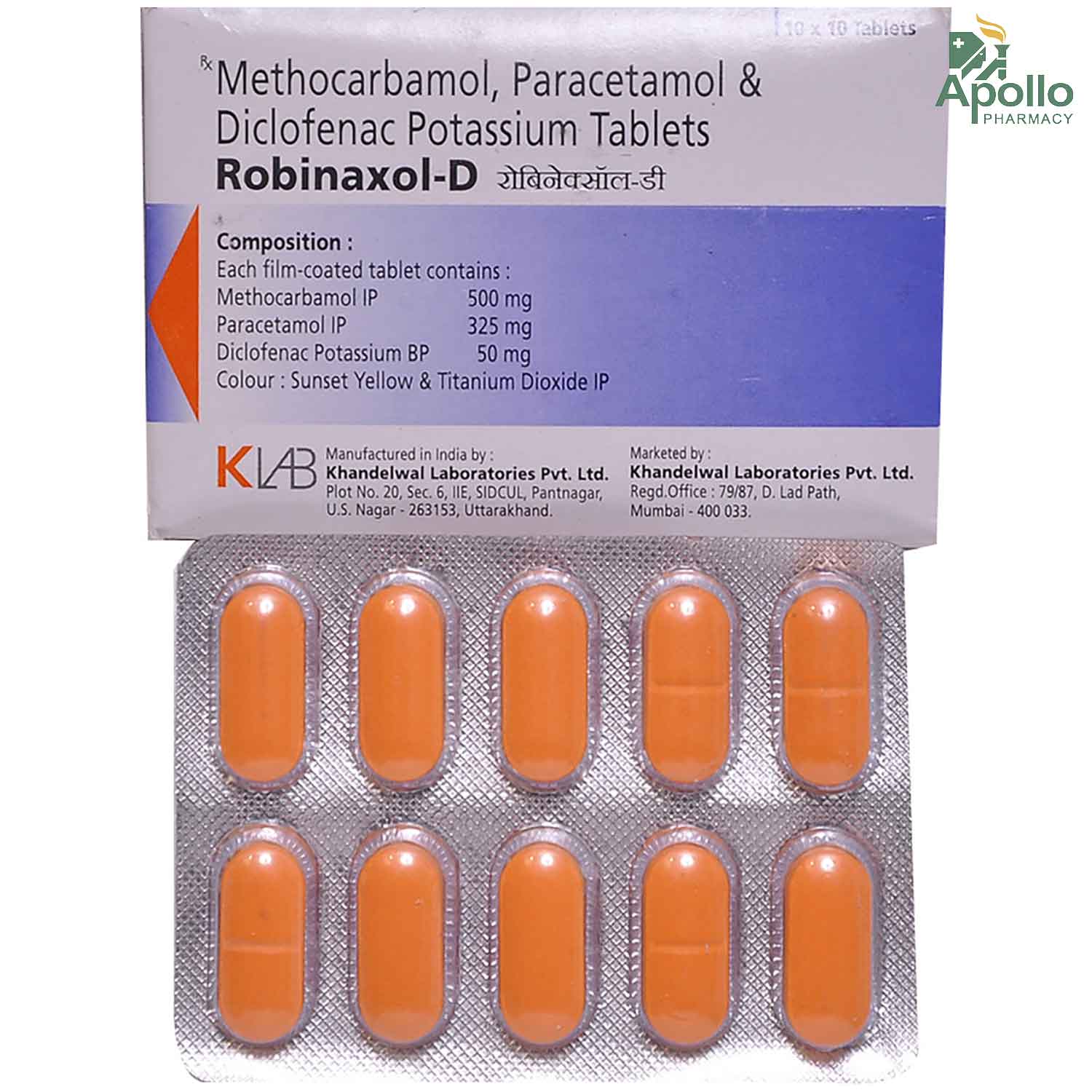Diclofenac+methocarbamol+paracetamol
About Diclofenac+methocarbamol+paracetamol
Diclofenac+methocarbamol+paracetamol belongs to the group of medicines called 'pain killer' and 'muscle relaxant' used to reduce and relieve the muscle spasms due to pain and injury. Besides this, it also treats tetanus conditions (lockjaw) which are characterized by painful tightening muscles. Muscle spasm is the sudden painful, and involuntary contractions of the muscle, which occurs when the nerve impulses that control the muscle movements are damaged or interrupted. Muscle pain (myalgia) can be caused due to injury, infection, loss of blood flow to the muscle, infection, or a tumour. Tetanus is a nervous system disorder leading to painful muscle contraction, mainly affecting jaw and neck muscles.
Diclofenac+methocarbamol+paracetamol contains three medicines namely diclofenac, methocarbamol, paracetamol. Diclofenac+methocarbamol+paracetamol contains diclofenac which works by blocking the action of a chemical messenger known as cyclo-oxygenase (COX) which causes pain and swelling at the injured or damaged tissue site. On the other hand, paracetamol acts as a mild analgesic (mild pain reducer) and antipyretic (fever reducer), which enhances the pain relief action of Diclofenac. Additionally, it also helps to relieve toothache, ear pain, backache, and other musculoskeletal-related pain. Methocarbamol is a muscle relaxant that works by blocking pain sensation (nerve impulse) sent to the brain. Thus, Diclofenac+methocarbamol+paracetamol works on the central nervous system (spinal cord and brain), thereby maintaining muscle strength and relieving muscle spasms or stiffness.
Take Diclofenac+methocarbamol+paracetamol as prescribed by your doctor. You are advised to take Diclofenac+methocarbamol+paracetamol for as long as your doctor has prescribed it for you depending on your medical condition. In some cases, you may experience nausea, heartburn, vomiting, diarrhoea, stomach pain, sleepiness, and loss of appetite. Most of these side-effects do not require medical attention and will resolve gradually over time. However, you are suggested to talk to your doctor if you experience these side-effects persistently.
Continue taking Diclofenac+methocarbamol+paracetamol for as long as your doctor has prescribed it. Before taking Diclofenac+methocarbamol+paracetamol inform your doctor if you have liver disease, kidney disease, peptic ulcer, and heart disease. Consult your doctor before taking Diclofenac+methocarbamol+paracetamol if you are pregnant or breast-feeding. Diclofenac+methocarbamol+paracetamol is not recommended for children below 16 years of age. Diclofenac+methocarbamol+paracetamol may affect driving ability as it causes headaches, blurred vision, sleepiness, dizziness, or drowsiness. Yes, you can drink alcohol while taking diclofenac. But drinking too much alcohol may irritate your stomach.
Uses of Diclofenac+methocarbamol+paracetamol
Medicinal Benefits
Diclofenac+methocarbamol+paracetamol belongs to the group of medicines called 'muscle relaxant' and ‘pain killer’ used to reduce and relieve the muscle spasms due to pain and injury. Diclofenac+methocarbamol+paracetamol contains three medicines namely diclofenac, methocarbamol, paracetamol. Diclofenac+methocarbamol+paracetamol contains diclofenac which works by blocking the action of a chemical messenger known as cyclo-oxygenase (COX) which causes pain and swelling at the injured or damaged tissue site. On the other hand, paracetamol acts as a mild analgesic (mild pain reducer) and antipyretic (fever reducer), which enhances the pain relief action of Diclofenac. Additionally, it also helps to relieve toothache, ear pain, backache, and other musculoskeletal-related pain. Methocarbamol is a muscle relaxant that works by blocking pain sensation (nerve impulse) sent to the brain. Thus, Diclofenac+methocarbamol+paracetamol works on the central nervous system (spinal cord and brain), thereby maintaining muscle strength and relieving muscle spasms or stiffness.
Directions for Use
- Diclofenac+methocarbamol+paracetamol can be taken with food to prevent stomach upset, or as advised by your doctor.
- Follow your doctor's instructions on the dosage and timing of this medication to ensure safety.
- Swallow it as a whole with a glass of water.
- Do not chew, crush or break it.
Storage
Side Effects of Diclofenac+methocarbamol+paracetamol
- Nausea
- Heartburn
- Vomiting
- Diarrhoea
- Stomach pain
- Sleepiness
- Loss of appetite
Drug Warnings
Continue taking Diclofenac+methocarbamol+paracetamol for as long as your doctor has prescribed it. Before taking Diclofenac+methocarbamol+paracetamol inform your doctor if you have liver disease, kidney disease, peptic ulcer, and heart disease. Inform your doctor before taking Diclofenac+methocarbamol+paracetamol if you have gastrointestinal bleeding, bypass surgery, and skin allergies. Consult your doctor before taking Diclofenac+methocarbamol+paracetamol if you are pregnant or breast-feeding. Diclofenac+methocarbamol+paracetamol is not recommended for children below 16 years of age. Diclofenac+methocarbamol+paracetamol may affect driving ability as it causes headaches, blurred vision, sleepiness, dizziness, or drowsiness. Yes, you can drink alcohol while taking diclofenac. But drinking too much alcohol may irritate your stomach.
Drug Interactions
Drug-Drug Interaction: Diclofenac+methocarbamol+paracetamol is shown to interact with antigout medicines (oxyphenbutazone), pain killer (metamizole, ketorolac, celecoxib, codeine, tramadol), anticancer medicines (methotrexate, altretamine, busulfan), medicines for heart disease (apixaban), anti TB (isoniazid).
Drug-Food Interaction: Avoid alcohol intake and tobacco consumption with Diclofenac+methocarbamol+paracetamol as it may cause increased drowsiness, dizziness, and lack of concentration.
Drug-Disease Interaction: Diclofenac+methocarbamol+paracetamol may have interactions with liver disease, kidney dysfunction, heart disease, gastrointestinal bleeding, and peptic ulcers.
Drug-Drug Interactions Checker List:
Safety Advice

Alcohol
cautionYes, you can drink alcohol while taking diclofenac. But drinking too much alcohol may irritate your stomach.

Pregnancy
unsafeDiclofenac+methocarbamol+paracetamol can be used during pregnancy but only under the supervision of a physician. Should not be given in the last trimester as can lead to fetal damage.

Breast Feeding
cautionYour doctor will weigh the benefits and any potential risks before prescribing it to you. Please consult your doctor.

Driving
unsafeDiclofenac+methocarbamol+paracetamol may affect driving ability as it causes headaches, blurred vision, sleepiness, dizziness, or drowsiness.

Liver
cautionDose adjustment may be needed in patients with severe liver problems as it contains paracetamol. Please consult your doctor if you have a liver impairment or any concerns regarding this.

Kidney
unsafeThis Diclofenac+methocarbamol+paracetamol is not recommended for patients with kidney disease. Please consult your doctor if you have kidney impairment or any concerns regarding this.

Children
unsafeDiclofenac+methocarbamol+paracetamol is not recommended for children below 16 years of age without the doctor's consent.
Habit Forming
Diet & Lifestyle Advise
- Avoid consuming alcohol while you are on Diclofenac+methocarbamol+paracetamol.
- Avoid wearing tight-fitting clothes, instead, wear loose garments.
- Rest well, get plenty of sleep (at least 8 hours for adults).
- Hot or cold therapy can help treat muscle spasms. Apply an ice-pack or hot-pack on the muscle for 15-20 minutes.
Patients Concern
Disease/Condition Glossary
Muscle spasm: The sudden involuntary contractions of the muscle can be painful and uncomfortable. When the nerve impulses that control the muscle movements are damaged or interrupted, it could lead to muscle spasms. Symptoms include muscle tightness, joint stiffness, unusual posture, difficulty moving, pain in affected muscles, and joints. Fatigue (weakness), stress, extreme heat or cold, infection, and tight clothing can trigger muscle spasms. Muscle relaxants and exercise can treat muscle spasms. Muscle relaxants sedate the muscle and help in inhibiting painful contractions. Exercise helps in muscle stretching so that they are less likely to spasm, tear, and sprain.
Musculoskeletal pain: It is generally caused by disorders of bones, joints, muscles, tendons, ligaments, or a combination. Injuries (mostly sports-related injuries) are the most common cause of musculoskeletal pain. Muscle pain (myalgia) can be caused due to injury, infection, loss of blood flow to the muscle, infection, or a tumour. Extreme tissue pain and inflammation caused due to sprains, strains, or trauma, or post-surgery may require a prolonged amount of time to heal.
Osteoarthritis: It is the most common form of joint disorder that occurs when the protective cartilage that cushions the ends of your bones wears down over time. It can damage any joint, thereby affecting joints in your hands, knees, hips, and spine.
FAQs
Diclofenac+methocarbamol+paracetamol is used to reduce and relieve muscle spasms due to pain and injury. Besides this, it also helps treat tetanus conditions (lockjaw) which are characterised by painful tightening muscles.
Diclofenac+methocarbamol+paracetamol contains three medicines namely diclofenac, methocarbamol, paracetamol. Diclofenac+methocarbamol+paracetamol contains diclofenac which works by blocking the action of a chemical messenger known as cyclo-oxygenase (COX) which causes pain and swelling at the injured or damaged tissue site. On the other hand, paracetamol acts as a mild analgesic (mild pain reducer) and antipyretic (fever reducer), which enhances the pain relief action of Diclofenac. Additionally, it also helps to relieve toothache, ear pain, backache, and other musculoskeletal-related pain. Methocarbamol is a muscle relaxant that works by blocking pain sensation (nerve impulse) sent to the brain. Thus, Diclofenac+methocarbamol+paracetamol works on the central nervous system (spinal cord and brain), thereby maintaining muscle strength and relieving muscle spasms or stiffness.
No, Diclofenac+methocarbamol+paracetamol is not indicated for stomach pain. If you have stomach pain post-ingestion, it may be a sign of stomach ulcer or gastric bleeding. Do not take Diclofenac+methocarbamol+paracetamol in this condition. It is better to inform your doctor in case of stomach pain post-ingestion of this medication.
Overdose symptoms of Diclofenac+methocarbamol+paracetamol may include nausea (being sick), extreme drowsiness, fainting, seizure, or coma. If you experience any of these signs immediately consult a doctor.
No, Diclofenac+methocarbamol+paracetamol should not be taken as a long-term medication as it may lead to stomach ulcers/bleeding and kidney problems. For best results of Diclofenac+methocarbamol+paracetamol, take it in doses and duration mentioned by your doctor.
Yes, Diclofenac+methocarbamol+paracetamol is a short-term medication and if you feel better you can stop taking Diclofenac+methocarbamol+paracetamol, but only after consulting your doctor.




